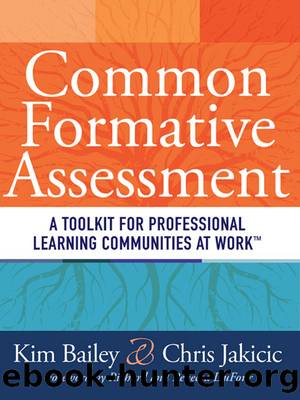Common Formative Assessment by Bailey Kim;Jakicic Chris;

Author:Bailey, Kim;Jakicic, Chris;
Language: eng
Format: epub
Publisher: Solution Tree
Published: 2011-08-15T00:00:00+00:00
Step One: Decide What to Assess
In chapter 4, you learned how to unwrap state standards to get a better understanding of their meaning. As part of that process, you uncovered specific learning targets that your team discussed in depth, agreeing on which were most important to teach, as well as the expected thinking level for students for each target. The targets you identify as the most important become the basis for your common formative assessment plan. Formative assessments are written around these specific learning targets, rather than around state standards. However, your team does not have to assess each learning target it has identifiedâonly those determined to be critical for students to know and be able to do. This means the team will view some of the unwrapped targets as either less important or as scaffolding skills that lead to the understanding of another target. The team decides which targets have the most value and designs the assessment around those targets.
Letâs look at an example. At Emerson Elementary, the fifth-grade team is teaching the following Common Core State Standard in math:
Add and subtract fractions with unlike denominators (including mixed numbers) by replacing given fractions with equivalent fractions in such a way as to produce an equivalent sum or difference of fractions with like denominators. (Common Core State Standards Initiative, 2010c, p. 36)
Team members know there are likely to be questions on the state tests that ask students to add fractions with like and unlike denominators, and perhaps to add mixed numbers as well. Depending on how the state displays student data, teachers may be able to identify students who have difficulty with this standard, but they are unlikely to know why students didnât understand.
Consider, instead, what would happen if this team created a common formative assessment that would provide better information, leading to stronger interventions. Using the process of unwrapping explained in chapter 4, the team unwraps the standard and lists all of the learning targets a student needs to know to be able to add and subtract fractions, including knowing the terms numerator and denominator, understanding what fractions with like and unlike denominators are, knowing how to find the least common denominator, and understanding and being able to apply the algorithm to add fractions (convert all fractions to their equivalent fractions with a common denominator, add the numerators, and keep the same denominator). The team decides to give a short common formative assessment after teachers have taught students to find the least common denominator. Based on the results of this assessment, teachers will easily be able to group students together who didnât understand that specific learning target and provide them with more time and support. Had they waited until the end of the unit and given a test on adding and subtracting fractions, they would know which students didnât understand how to add and subtract fractions, but not why they didnât understand.
To determine what to assess, look at the learning targets your team identified for one unit of instruction through the unwrapping process.
Download
This site does not store any files on its server. We only index and link to content provided by other sites. Please contact the content providers to delete copyright contents if any and email us, we'll remove relevant links or contents immediately.
| Administration | Assessment |
| Educational Psychology | Experimental Methods |
| History | Language Experience Approach |
| Philosophy & Social Aspects | Reform & Policy |
| Research |
The Art of Coaching Workbook by Elena Aguilar(50983)
Trainspotting by Irvine Welsh(21518)
Twilight of the Idols With the Antichrist and Ecce Homo by Friedrich Nietzsche(18501)
Fangirl by Rainbow Rowell(9095)
Periodization Training for Sports by Tudor Bompa(8170)
Change Your Questions, Change Your Life by Marilee Adams(7634)
This Is How You Lose Her by Junot Diaz(6793)
Asking the Right Questions: A Guide to Critical Thinking by M. Neil Browne & Stuart M. Keeley(5632)
Grit by Angela Duckworth(5520)
Red Sparrow by Jason Matthews(5390)
Paper Towns by Green John(5087)
Room 212 by Kate Stewart(5035)
Ken Follett - World without end by Ken Follett(4644)
Housekeeping by Marilynne Robinson(4342)
The Sports Rules Book by Human Kinetics(4290)
Double Down (Diary of a Wimpy Kid Book 11) by Jeff Kinney(4206)
Papillon (English) by Henri Charrière(4195)
The Motorcycle Diaries by Ernesto Che Guevara(4009)
Exercise Technique Manual for Resistance Training by National Strength & Conditioning Association(3955)
